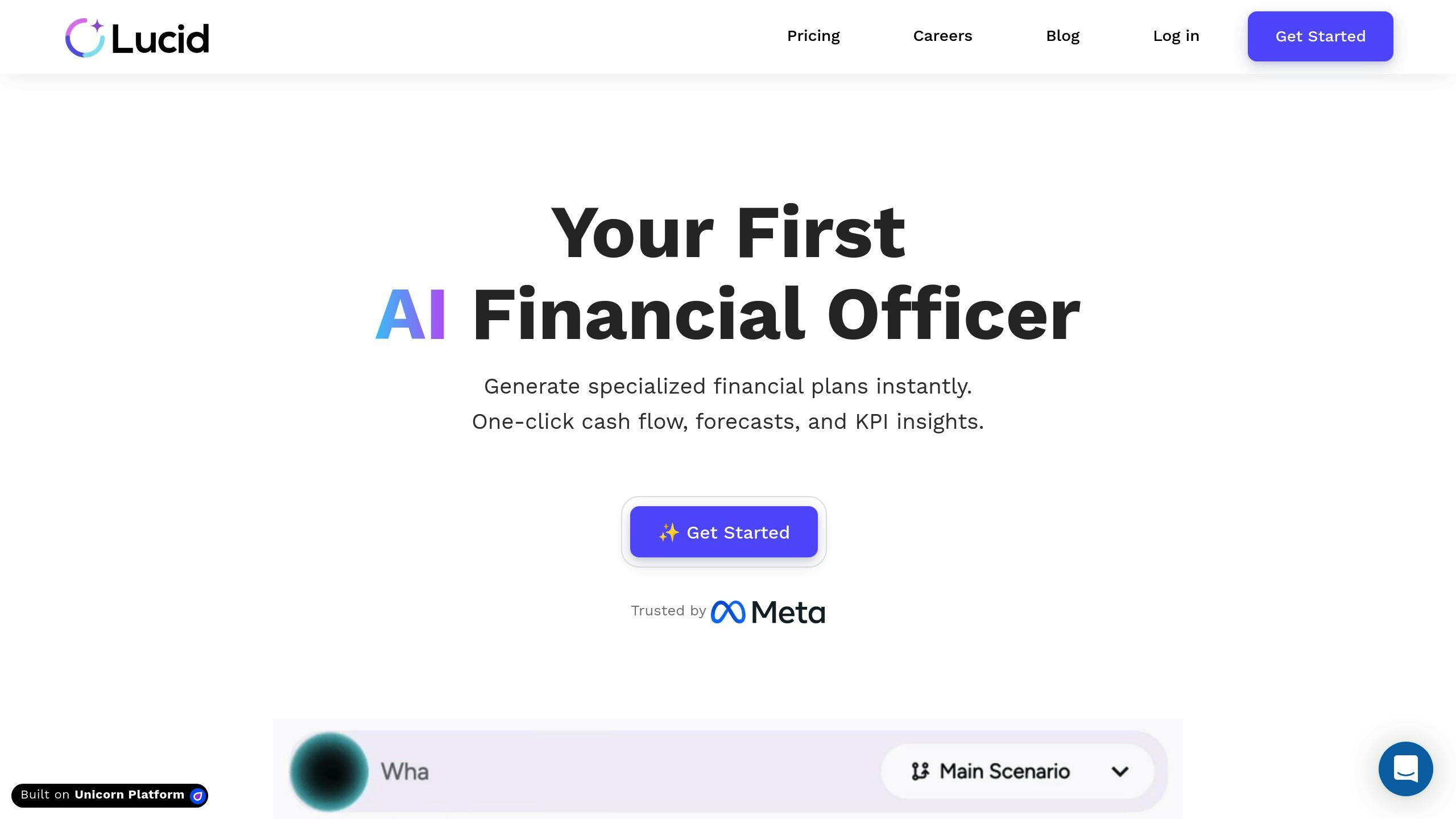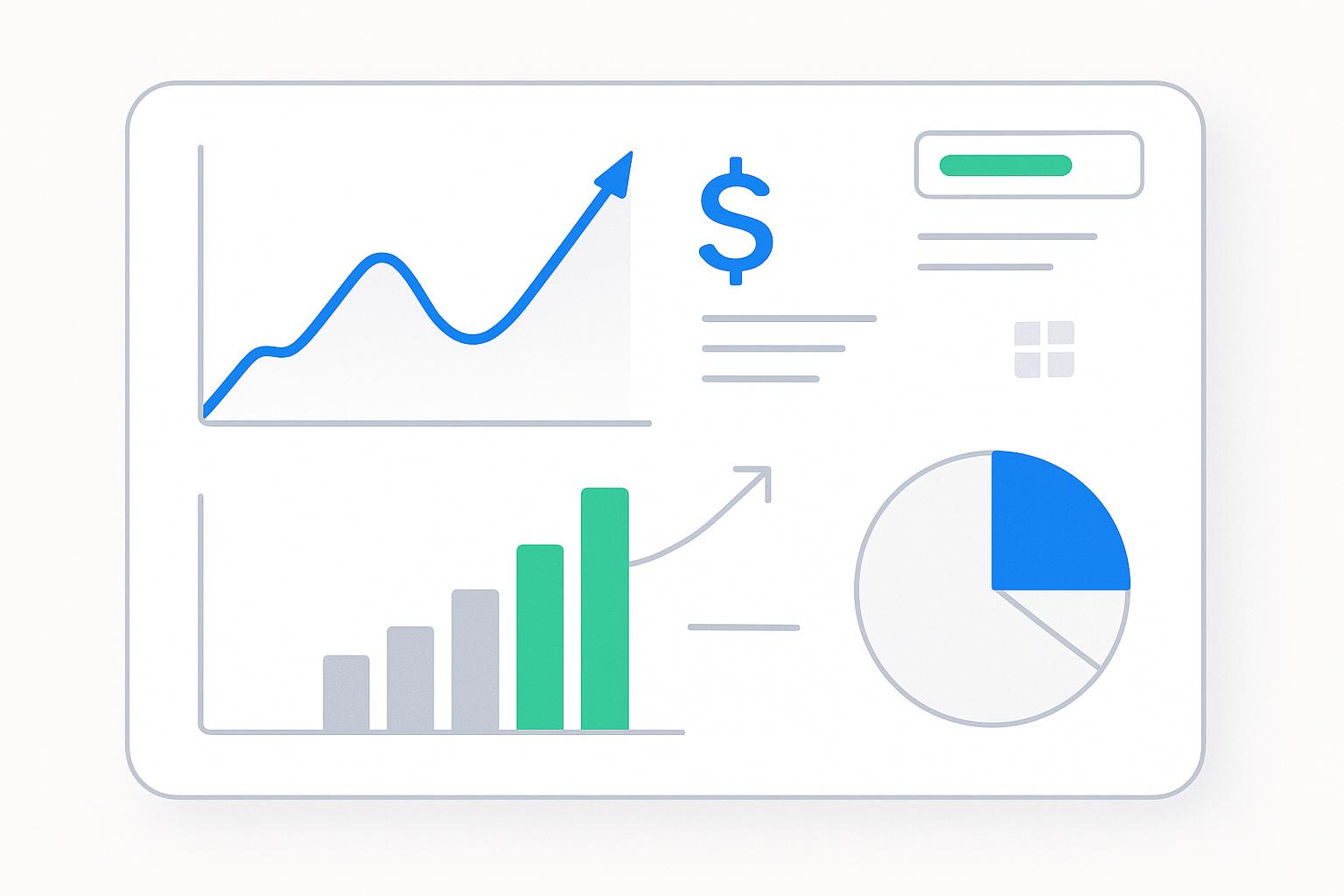AI is transforming financial planning by providing real-time, accurate revenue forecasts using advanced algorithms. Here's what you need to know:
- What it does: AI analyzes large datasets to predict revenue, spot trends, and improve decision-making.
- Who benefits: Startups and SMBs gain better cash flow management, scenario planning, and reduced forecasting errors (up to 30%).
- How it works: Tools like Lucid Financials integrate with systems (e.g., QuickBooks) for live updates, fixing errors, and automating forecasts.
- Challenges: Requires clean data, training, and attention to security.
Quick Tip: Start by connecting AI tools to your existing systems and training your team to maximize results.
Improve Your Financial Projection Plan Significantly with this AI Tool
How AI Revenue Projections Work
AI revenue projections use advanced tools and live data to create precise financial forecasts. These systems move beyond traditional spreadsheet-based methods by utilizing multiple data sources and sophisticated algorithms.
AI Models and Algorithms Simplified
AI revenue forecasting is powered by two key technologies: time series analysis and neural networks. Time series analysis spots recurring revenue patterns, while neural networks examine complex connections between factors like customer behavior and market trends.
This combination uncovers both obvious and hidden revenue influences, helping businesses make smarter financial decisions. By blending historical data with current market conditions, AI offers insights that older methods often overlook [1].
Real-Time Data Integration with AI Tools
Modern AI financial platforms connect with systems like QuickBooks, payroll software, and banks to provide live insights into revenue, expenses, and cash flow. For example, tools like Lucid Financials automatically process data from various sources to deliver instant financial updates.
These platforms ensure reliable forecasts by:
- Fixing data errors
- Filling missing information
- Creating consistent analyses
- Maintaining forecast accuracy
This automation minimizes human error and frees up financial teams to focus on strategic planning [1][5]. With these systems, businesses can easily incorporate AI-driven projections into their financial strategies, turning raw data into actionable plans.
Using AI Revenue Projections in Financial Planning
How Platforms Like Lucid Financials Help

AI-powered platforms are changing the way businesses handle financial planning. Tools like Lucid Financials simplify the process by connecting directly to systems like QuickBooks and payroll software. This integration allows for real-time updates to financial projections, cutting down on manual errors and speeding up decision-making.
These platforms also shine when it comes to scenario planning. Businesses can assess different financial outcomes quickly, making it easier to prepare for various possibilities.
Planning Scenarios with AI
AI makes it possible to evaluate multiple financial scenarios in seconds, offering insights that would take much longer to gather manually. By combining past data with current market trends, AI can predict a range of financial outcomes.
Take Aurorium, for example. Their use of AI-driven forecasting improved their budgeting process by quickly spotting anomalies and enabling better decisions. As Grant Halloran, CEO of Planful, put it:
"AI for Finance is inevitable" [3]
AI doesn't just crunch numbers; it identifies hidden trends, adjusts projections on the fly, and calculates probabilities for different outcomes. This level of precision takes scenario planning to the next level.
Tips for Adding AI to Your Workflow
Bringing AI into your financial planning requires a thoughtful approach. Start by integrating AI tools with your current software to ensure data stays consistent. For instance, Lucid Financials simplifies this step by automating data integration and validation, giving you an accurate starting point with minimal effort.
| Implementation Phase | Action Items | Expected Outcome |
|---|---|---|
| Initial Setup | Connect data sources, validate historical data | Reliable baseline for AI-driven forecasts |
| Team Training | Offer hands-on sessions | Confident and effective tool usage |
| Monitoring | Track forecast accuracy, tweak settings | Better prediction reliability |
Studies show that AI can reduce forecasting errors by up to 30% compared to traditional methods [6]. To get similar results, ensure your team knows both the strengths and limits of the AI tools you choose.
sbb-itb-17e8ec9
Pros and Cons of AI Revenue Projections
Benefits for Startups and Small Businesses
AI revenue projections can be a game-changer for startups and small businesses, especially when it comes to improving financial accuracy and resource planning. For instance, AI can reduce forecasting errors by up to 30%, enabling companies to make better financial decisions and avoid costly mistakes.
The use of AI in finance is growing fast. Between 2023 and 2024, adoption increased by 21%, and now, 58% of organizations are using AI tools to support their financial operations [6].
Challenges to Consider
While AI offers many advantages, there are some obstacles businesses need to address. Tools like Lucid Financials rely heavily on clean and accurate data from systems like QuickBooks or payroll software. Without proper data integration, the forecasts may not be reliable [4].
Another critical focus is security and compliance. AI platforms must ensure data privacy through encryption and strict access controls, especially when handling sensitive financial information [4].
Additionally, implementing AI tools often requires training. Teams need to learn how to use these systems and interpret the results effectively, which can increase the time and cost of initial deployment.
These challenges highlight the importance of thoughtful planning when choosing an AI financial tool.
Comparing AI Financial Tools
Despite the hurdles, AI-powered tools offer clear advantages over traditional approaches. Here's a breakdown of how they stack up:
| Feature Category | Traditional Tools | AI-Powered Platforms | Impact on Business |
|---|---|---|---|
| Forecast Accuracy | Basic linear projections | Advanced pattern recognition | More precise forecasts |
| Processing Speed | Hours or days | Real-time updates | Quicker decisions |
| Data Integration | Manual input required | Automated connections | Fewer errors |
| Scenario Planning | Limited scenarios | Dynamic, adaptive scenarios | Improved risk analysis |
The move toward AI-driven financial planning reflects its growing role in modern business. As TTMS puts it:
"AI financial forecasting enhances the accuracy of forecasts by processing and analyzing vast datasets with precision, reducing the likelihood of errors common in traditional methods" [2].
Examples of AI in Financial Planning
How Startups Use AI Tools
Startups are turning to AI tools like Lucid Financials to make operations smoother and improve accuracy. For instance, a tech startup in Miami managed to cut planning time in half and boost forecast accuracy by 25%. Meanwhile, a retail startup saw a 20% jump in sales by using AI for demand forecasting and better resource allocation. These tools allow startups to simplify their workflows and focus on scaling their businesses.
How SMBs Benefit from AI Tools
For small and medium-sized businesses (SMBs), AI tools tackle everyday challenges and enhance efficiency. A manufacturing company, for example, reduced its accounts receivable days by 30% with AI-powered cash flow analysis, leading to better working capital. Similarly, a professional services firm using Lucid Financials achieved a 25% improvement in cash flow accuracy, cut financial management time in half, and reduced forecasting errors by 30%.
During the COVID-19 pandemic, these tools became even more crucial. SMBs using advanced financial planning platforms could quickly adjust their projections and develop contingency plans based on real-time market data. This flexibility helped them stay operational and manage uncertainty effectively.
These examples show how AI is reshaping financial planning, making it a game-changer for businesses across various sectors.
Conclusion and Future of AI in Financial Planning
Key Takeaways
AI is transforming financial planning by enabling real-time, dynamic forecasting that integrates smoothly with existing financial systems. By combining advanced algorithms with machine learning, modern platforms now offer self-improving models that go beyond static projections. This shift allows businesses to embrace more data-driven and adaptable financial strategies.
As more companies adopt AI tools, upcoming developments are set to refine forecasting accuracy and improve accessibility.
The Future of AI Financial Tools
AI tools are evolving to deliver better predictive accuracy and seamless real-time integration, giving businesses faster insights and smarter decision-making capabilities. For startups and small businesses, these advancements will make sophisticated financial tools more accessible, leveling the playing field in competitive markets.
Here’s a look at some expected advancements:
| Feature | Impact |
|---|---|
| Predictive Analytics | Improved long-term forecasts with fewer errors |
| Real-time Integration | Instant updates by connecting with multiple data sources |
| Automated Insights | Actionable insights to guide smarter financial decisions |
| User Experience | Simplified tools that are easy for non-experts to use |
AI financial tools will continue to address current challenges, such as improving data quality, minimizing biases in algorithms, and enhancing scenario planning. These advancements will make AI-driven financial planning even more effective, especially for startups and smaller businesses aiming to stay competitive.
FAQs
What is the AI model for financial forecasting?
AI models for financial forecasting analyze large datasets, recognize historical patterns, and improve their accuracy over time. Unlike older methods, they can spot trends and adjust to changing conditions in real-time. These models handle multiple variables at once, adapting to market shifts and delivering more accurate predictions through ongoing learning and pattern recognition.
This ability to process and adapt quickly makes AI a powerful tool for businesses aiming to streamline financial planning and decision-making. But how well do these models actually perform? Let's take a closer look.
Is AI good at forecasting?
AI stands out in financial forecasting thanks to its ability to process data efficiently and recognize patterns. For example, Jarsy, Inc. shared their experience:
"Our finance team spends 40% less time with AI forecasting compared to manual work. This saves time and leaves us with more time and effort to make key business decisions instead of doing computations." - Chunyang Shen, Co-founder of Jarsy, Inc. [6]
AI-driven forecasting tools offer several clear benefits for businesses:
- Automatic detection of market trends and seasonal patterns
- Real-time updates using the most current data
- Reduced human bias and fewer calculation errors
- Efficient management of increasing data volumes
When paired with existing financial systems, these tools help businesses make faster, more informed decisions. Their ability to continuously learn and process massive amounts of information makes them especially useful for today's financial planning needs [1].


